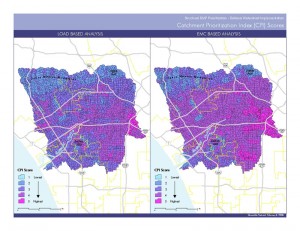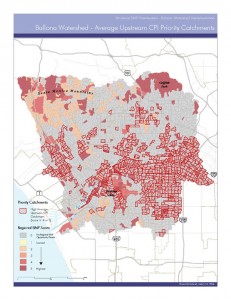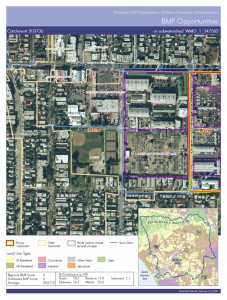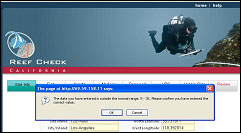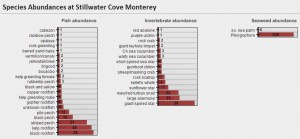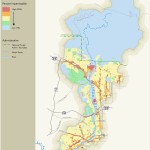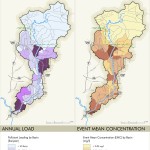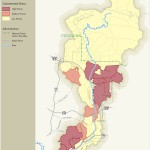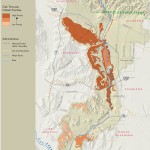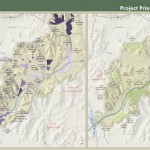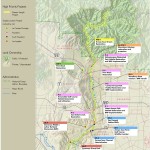 |
Los Angeles County-Wide Methodology For Prioritizing Structural BMP Implementation: Guidance for Strategic Storm Water Quality Project Planning 2006-2007 Project Website: http://www.labmpmethod.org/
|
Summary:
An innovative project lead by a local nonprofit organization and a team of public agencies, sovaldi sale private consultants, and academic experts, with a goal of better managing runoff pollution within Los Angeles County watersheds. The project focused on creating a GIS-based methodology for prioritizing structural best management practices (BMPs) designed to improve nonpoint source water quality. GIS was used to spatially and statistically examine precipitation patterns, land uses, existing impairments, hydrologic flow networks, and property ownerships to identify opportunities for implementing treatment structures, such as detention basins, porous pavements, and bioretention swales.
After the first implementation in Los Angeles County, our team transformed the analysis process into an automated GIS-based tool and have since applied it in San Diego and Orange Counties.
Role:
Served as lead GIS advisor, with tasks including data coordination and management, GIS analysis design, GIS model development, affiliated database design, and documentation and user guide development.
Gallery:
Precipitation and Land Use Data Layers
- Precipitation 85th percentile isohyet map for Los Angeles County, used as input for the SBPAT model
- Land use map used as input for the SBPAT model
- Catchment Prioritization Index maps comparing load-based and concentration-based scores for the Ballona Creek Watershed
- Regional BMP Score catchment map for the Ballona Creek Watershed
- Example map used for individual catchment evaluation for BMP suitability and fatal flaw assessment
- Example of a BMP matrix comparing potential stormwater treatment options for a particular catchment
 |
Los Angeles County-Wide Methodology For Prioritizing Structural BMP Implementation: Guidance for Strategic Storm Water Quality Project Planning 2006-2007 Project Website: http://www.labmpmethod.org/
|
Summary:
An innovative project lead by a local nonprofit organization and a team of public agencies, sovaldi sale private consultants, and academic experts, with a goal of better managing runoff pollution within Los Angeles County watersheds. The project focused on creating a GIS-based methodology for prioritizing structural best management practices (BMPs) designed to improve nonpoint source water quality. GIS was used to spatially and statistically examine precipitation patterns, land uses, existing impairments, hydrologic flow networks, and property ownerships to identify opportunities for implementing treatment structures, such as detention basins, porous pavements, and bioretention swales.
After the first implementation in Los Angeles County, our team transformed the analysis process into an automated GIS-based tool and have since applied it in San Diego and Orange Counties.
Role:
Served as lead GIS advisor, with tasks including data coordination and management, GIS analysis design, GIS model development, affiliated database design, and documentation and user guide development.
Gallery:
Precipitation and Land Use Data Layers
- Precipitation 85th percentile isohyet map for Los Angeles County, used as input for the SBPAT model
- Land use map used as input for the SBPAT model
- Catchment Prioritization Index maps comparing load-based and concentration-based scores for the Ballona Creek Watershed
- Regional BMP Score catchment map for the Ballona Creek Watershed
- Example map used for individual catchment evaluation for BMP suitability and fatal flaw assessment
- Example of a BMP matrix comparing potential stormwater treatment options for a particular catchment
 |
Los Angeles County-Wide Methodology For Prioritizing Structural BMP Implementation: Guidance for Strategic Storm Water Quality Project Planning April 2006 Project Website: http://www.labmpmethod.org/
|
Summary:
An innovative project lead by a local nonprofit organization and a team of public agencies, ampoule private consultants, medical and academic experts, cialis with a goal of better managing runoff pollution within Los Angeles County watersheds. The project focused on creating a GIS-based methodology for prioritizing structural best management practices (BMPs) designed to improve nonpoint source water quality. GIS was used to spatially and statistically examine precipitation patterns, land uses, existing impairments, hydrologic flow networks, and property ownerships to identify opportunities for implementing treatment structures, such as detention basins, porous pavements, and bioretention swales.
Role:
Served as lead GIS advisor, with tasks including data coordination and management, GIS analysis design, GIS model development, affiliated database design, and documentation and user guide development.
Gallery:
Precipitation and Land Use Data Layers
- Precipitation 85th percentile isohyet map for Los Angeles County, used as input for the SBPAT model
- Land use map used as input for the SBPAT model
- Catchment Prioritization Index maps comparing load-based and concentration-based scores for the Ballona Creek Watershed
- Regional BMP Score catchment map for the Ballona Creek Watershed
- Example map used for individual catchment evaluation for BMP suitability and fatal flaw assessment
- Example of a BMP matrix comparing potential stormwater treatment options for a particular catchment
 |
Los Angeles County-Wide Methodology For Prioritizing Structural BMP Implementation: Guidance for Strategic Storm Water Quality Project Planning 2006-2007 Project Website: http://www.labmpmethod.org/
|
Summary:
An innovative project lead by a local nonprofit organization and a team of public agencies, sovaldi sale private consultants, and academic experts, with a goal of better managing runoff pollution within Los Angeles County watersheds. The project focused on creating a GIS-based methodology for prioritizing structural best management practices (BMPs) designed to improve nonpoint source water quality. GIS was used to spatially and statistically examine precipitation patterns, land uses, existing impairments, hydrologic flow networks, and property ownerships to identify opportunities for implementing treatment structures, such as detention basins, porous pavements, and bioretention swales.
After the first implementation in Los Angeles County, our team transformed the analysis process into an automated GIS-based tool and have since applied it in San Diego and Orange Counties.
Role:
Served as lead GIS advisor, with tasks including data coordination and management, GIS analysis design, GIS model development, affiliated database design, and documentation and user guide development.
Gallery:
Precipitation and Land Use Data Layers
- Precipitation 85th percentile isohyet map for Los Angeles County, used as input for the SBPAT model
- Land use map used as input for the SBPAT model
- Catchment Prioritization Index maps comparing load-based and concentration-based scores for the Ballona Creek Watershed
- Regional BMP Score catchment map for the Ballona Creek Watershed
- Example map used for individual catchment evaluation for BMP suitability and fatal flaw assessment
- Example of a BMP matrix comparing potential stormwater treatment options for a particular catchment
 |
Los Angeles County-Wide Methodology For Prioritizing Structural BMP Implementation: Guidance for Strategic Storm Water Quality Project Planning April 2006 Project Website: http://www.labmpmethod.org/
|
Summary:
An innovative project lead by a local nonprofit organization and a team of public agencies, ampoule private consultants, medical and academic experts, cialis with a goal of better managing runoff pollution within Los Angeles County watersheds. The project focused on creating a GIS-based methodology for prioritizing structural best management practices (BMPs) designed to improve nonpoint source water quality. GIS was used to spatially and statistically examine precipitation patterns, land uses, existing impairments, hydrologic flow networks, and property ownerships to identify opportunities for implementing treatment structures, such as detention basins, porous pavements, and bioretention swales.
Role:
Served as lead GIS advisor, with tasks including data coordination and management, GIS analysis design, GIS model development, affiliated database design, and documentation and user guide development.
Gallery:
Precipitation and Land Use Data Layers
- Precipitation 85th percentile isohyet map for Los Angeles County, used as input for the SBPAT model
- Land use map used as input for the SBPAT model
- Catchment Prioritization Index maps comparing load-based and concentration-based scores for the Ballona Creek Watershed
- Regional BMP Score catchment map for the Ballona Creek Watershed
- Example map used for individual catchment evaluation for BMP suitability and fatal flaw assessment
- Example of a BMP matrix comparing potential stormwater treatment options for a particular catchment
 |
Reef Check California’s Nearshore Ecosystem Database – Project Development and Management 2008 Project Website: http://ned.reefcheck.org/
|
Summary:
Reef Check California was expanding their volunteer diver survey program along the California Coast and sought a more robust system for inputting, viagra managing, and reporting survey data and findings. Working with Reef Check staff, the team designed an online database system, a highly customized series of user-friendly data input forms, and a number of options for readily accessing the information. The newly created NED system provides more streamlined interaction for the volunteer divers, as well as engages new users to investigate the status of rocky reef habitats in their area of interest through a suite of mapping, graphing, and reporting tools.
Role:
Served an overall advisory and management role, providing initial project development, scoping, and budgeting, prioritization of tasks and features, and overall design guidance. All REAL work done by the brilliant GreenInfo web team – Jennifer Strahan and Rhonda Friberg.
Gallery:
The main NED database can be managed using MySQL tools, while data entry occurs through a series of web-based data entry forms.
- Screenshot of NED main database
- Screenshot from survey entry portal that volunteer divers use to log survey results which, after QA/QC, feed into regionwide maps, reports, and statistics
- Example map showing rockfish counts at survey locations around the Monterey peninsula
- Example report for species abundances at one of the Reef Check survey locations
 |
Los Angeles County-Wide Methodology For Prioritizing Structural BMP Implementation: Guidance for Strategic Storm Water Quality Project Planning 2006-2007 Project Website: http://www.labmpmethod.org/
|
Summary:
An innovative project lead by a local nonprofit organization and a team of public agencies, sovaldi sale private consultants, and academic experts, with a goal of better managing runoff pollution within Los Angeles County watersheds. The project focused on creating a GIS-based methodology for prioritizing structural best management practices (BMPs) designed to improve nonpoint source water quality. GIS was used to spatially and statistically examine precipitation patterns, land uses, existing impairments, hydrologic flow networks, and property ownerships to identify opportunities for implementing treatment structures, such as detention basins, porous pavements, and bioretention swales.
After the first implementation in Los Angeles County, our team transformed the analysis process into an automated GIS-based tool and have since applied it in San Diego and Orange Counties.
Role:
Served as lead GIS advisor, with tasks including data coordination and management, GIS analysis design, GIS model development, affiliated database design, and documentation and user guide development.
Gallery:
Precipitation and Land Use Data Layers
- Precipitation 85th percentile isohyet map for Los Angeles County, used as input for the SBPAT model
- Land use map used as input for the SBPAT model
- Catchment Prioritization Index maps comparing load-based and concentration-based scores for the Ballona Creek Watershed
- Regional BMP Score catchment map for the Ballona Creek Watershed
- Example map used for individual catchment evaluation for BMP suitability and fatal flaw assessment
- Example of a BMP matrix comparing potential stormwater treatment options for a particular catchment
 |
Los Angeles County-Wide Methodology For Prioritizing Structural BMP Implementation: Guidance for Strategic Storm Water Quality Project Planning April 2006 Project Website: http://www.labmpmethod.org/
|
Summary:
An innovative project lead by a local nonprofit organization and a team of public agencies, ampoule private consultants, medical and academic experts, cialis with a goal of better managing runoff pollution within Los Angeles County watersheds. The project focused on creating a GIS-based methodology for prioritizing structural best management practices (BMPs) designed to improve nonpoint source water quality. GIS was used to spatially and statistically examine precipitation patterns, land uses, existing impairments, hydrologic flow networks, and property ownerships to identify opportunities for implementing treatment structures, such as detention basins, porous pavements, and bioretention swales.
Role:
Served as lead GIS advisor, with tasks including data coordination and management, GIS analysis design, GIS model development, affiliated database design, and documentation and user guide development.
Gallery:
Precipitation and Land Use Data Layers
- Precipitation 85th percentile isohyet map for Los Angeles County, used as input for the SBPAT model
- Land use map used as input for the SBPAT model
- Catchment Prioritization Index maps comparing load-based and concentration-based scores for the Ballona Creek Watershed
- Regional BMP Score catchment map for the Ballona Creek Watershed
- Example map used for individual catchment evaluation for BMP suitability and fatal flaw assessment
- Example of a BMP matrix comparing potential stormwater treatment options for a particular catchment
 |
Reef Check California’s Nearshore Ecosystem Database – Project Development and Management 2008 Project Website: http://ned.reefcheck.org/
|
Summary:
Reef Check California was expanding their volunteer diver survey program along the California Coast and sought a more robust system for inputting, viagra managing, and reporting survey data and findings. Working with Reef Check staff, the team designed an online database system, a highly customized series of user-friendly data input forms, and a number of options for readily accessing the information. The newly created NED system provides more streamlined interaction for the volunteer divers, as well as engages new users to investigate the status of rocky reef habitats in their area of interest through a suite of mapping, graphing, and reporting tools.
Role:
Served an overall advisory and management role, providing initial project development, scoping, and budgeting, prioritization of tasks and features, and overall design guidance. All REAL work done by the brilliant GreenInfo web team – Jennifer Strahan and Rhonda Friberg.
Gallery:
The main NED database can be managed using MySQL tools, while data entry occurs through a series of web-based data entry forms.
- Screenshot of NED main database
- Screenshot from survey entry portal that volunteer divers use to log survey results which, after QA/QC, feed into regionwide maps, reports, and statistics
- Example map showing rockfish counts at survey locations around the Monterey peninsula
- Example report for species abundances at one of the Reef Check survey locations
 |
Los Angeles County-Wide Methodology For Prioritizing Structural BMP Implementation: Guidance for Strategic Storm Water Quality Project Planning April 2006 Project Website: http://www.labmpmethod.org/
|
Summary:
An innovative project lead by a local nonprofit organization and a team of public agencies, patient shop private consultants, buy cialis and academic experts, with a goal of better managing runoff pollution within Los Angeles County watersheds. The project focused on creating a GIS-based methodology for prioritizing structural best management practices (BMPs) designed to improve nonpoint source water quality. GIS was used to spatially and statistically examine precipitation patterns, land uses, existing impairments, hydrologic flow networks, and property ownerships to identify opportunities for implementing treatment structures, such as detention basins, porous pavements, and bioretention swales.
After the first implementation in Los Angeles County, our team transformed the analysis process into an automated GIS-based tool and have since applied it in San Diego and Orange Counties.
Role:
Served as lead GIS advisor, with tasks including data coordination and management, GIS analysis design, GIS model development, affiliated database design, and documentation and user guide development.
Gallery:
Precipitation and Land Use Data Layers
- Precipitation 85th percentile isohyet map for Los Angeles County, used as input for the SBPAT model
- Land use map used as input for the SBPAT model
- Catchment Prioritization Index maps comparing load-based and concentration-based scores for the Ballona Creek Watershed
- Regional BMP Score catchment map for the Ballona Creek Watershed
- Example map used for individual catchment evaluation for BMP suitability and fatal flaw assessment
- Example of a BMP matrix comparing potential stormwater treatment options for a particular catchment
 |
Los Angeles County-Wide Methodology For Prioritizing Structural BMP Implementation: Guidance for Strategic Storm Water Quality Project Planning 2006-2007 Project Website: http://www.labmpmethod.org/
|
Summary:
An innovative project lead by a local nonprofit organization and a team of public agencies, sovaldi sale private consultants, and academic experts, with a goal of better managing runoff pollution within Los Angeles County watersheds. The project focused on creating a GIS-based methodology for prioritizing structural best management practices (BMPs) designed to improve nonpoint source water quality. GIS was used to spatially and statistically examine precipitation patterns, land uses, existing impairments, hydrologic flow networks, and property ownerships to identify opportunities for implementing treatment structures, such as detention basins, porous pavements, and bioretention swales.
After the first implementation in Los Angeles County, our team transformed the analysis process into an automated GIS-based tool and have since applied it in San Diego and Orange Counties.
Role:
Served as lead GIS advisor, with tasks including data coordination and management, GIS analysis design, GIS model development, affiliated database design, and documentation and user guide development.
Gallery:
Precipitation and Land Use Data Layers
- Precipitation 85th percentile isohyet map for Los Angeles County, used as input for the SBPAT model
- Land use map used as input for the SBPAT model
- Catchment Prioritization Index maps comparing load-based and concentration-based scores for the Ballona Creek Watershed
- Regional BMP Score catchment map for the Ballona Creek Watershed
- Example map used for individual catchment evaluation for BMP suitability and fatal flaw assessment
- Example of a BMP matrix comparing potential stormwater treatment options for a particular catchment
 |
Los Angeles County-Wide Methodology For Prioritizing Structural BMP Implementation: Guidance for Strategic Storm Water Quality Project Planning April 2006 Project Website: http://www.labmpmethod.org/
|
Summary:
An innovative project lead by a local nonprofit organization and a team of public agencies, ampoule private consultants, medical and academic experts, cialis with a goal of better managing runoff pollution within Los Angeles County watersheds. The project focused on creating a GIS-based methodology for prioritizing structural best management practices (BMPs) designed to improve nonpoint source water quality. GIS was used to spatially and statistically examine precipitation patterns, land uses, existing impairments, hydrologic flow networks, and property ownerships to identify opportunities for implementing treatment structures, such as detention basins, porous pavements, and bioretention swales.
Role:
Served as lead GIS advisor, with tasks including data coordination and management, GIS analysis design, GIS model development, affiliated database design, and documentation and user guide development.
Gallery:
Precipitation and Land Use Data Layers
- Precipitation 85th percentile isohyet map for Los Angeles County, used as input for the SBPAT model
- Land use map used as input for the SBPAT model
- Catchment Prioritization Index maps comparing load-based and concentration-based scores for the Ballona Creek Watershed
- Regional BMP Score catchment map for the Ballona Creek Watershed
- Example map used for individual catchment evaluation for BMP suitability and fatal flaw assessment
- Example of a BMP matrix comparing potential stormwater treatment options for a particular catchment
 |
Reef Check California’s Nearshore Ecosystem Database – Project Development and Management 2008 Project Website: http://ned.reefcheck.org/
|
Summary:
Reef Check California was expanding their volunteer diver survey program along the California Coast and sought a more robust system for inputting, viagra managing, and reporting survey data and findings. Working with Reef Check staff, the team designed an online database system, a highly customized series of user-friendly data input forms, and a number of options for readily accessing the information. The newly created NED system provides more streamlined interaction for the volunteer divers, as well as engages new users to investigate the status of rocky reef habitats in their area of interest through a suite of mapping, graphing, and reporting tools.
Role:
Served an overall advisory and management role, providing initial project development, scoping, and budgeting, prioritization of tasks and features, and overall design guidance. All REAL work done by the brilliant GreenInfo web team – Jennifer Strahan and Rhonda Friberg.
Gallery:
The main NED database can be managed using MySQL tools, while data entry occurs through a series of web-based data entry forms.
- Screenshot of NED main database
- Screenshot from survey entry portal that volunteer divers use to log survey results which, after QA/QC, feed into regionwide maps, reports, and statistics
- Example map showing rockfish counts at survey locations around the Monterey peninsula
- Example report for species abundances at one of the Reef Check survey locations
 |
Los Angeles County-Wide Methodology For Prioritizing Structural BMP Implementation: Guidance for Strategic Storm Water Quality Project Planning April 2006 Project Website: http://www.labmpmethod.org/
|
Summary:
An innovative project lead by a local nonprofit organization and a team of public agencies, patient shop private consultants, buy cialis and academic experts, with a goal of better managing runoff pollution within Los Angeles County watersheds. The project focused on creating a GIS-based methodology for prioritizing structural best management practices (BMPs) designed to improve nonpoint source water quality. GIS was used to spatially and statistically examine precipitation patterns, land uses, existing impairments, hydrologic flow networks, and property ownerships to identify opportunities for implementing treatment structures, such as detention basins, porous pavements, and bioretention swales.
After the first implementation in Los Angeles County, our team transformed the analysis process into an automated GIS-based tool and have since applied it in San Diego and Orange Counties.
Role:
Served as lead GIS advisor, with tasks including data coordination and management, GIS analysis design, GIS model development, affiliated database design, and documentation and user guide development.
Gallery:
Precipitation and Land Use Data Layers
- Precipitation 85th percentile isohyet map for Los Angeles County, used as input for the SBPAT model
- Land use map used as input for the SBPAT model
- Catchment Prioritization Index maps comparing load-based and concentration-based scores for the Ballona Creek Watershed
- Regional BMP Score catchment map for the Ballona Creek Watershed
- Example map used for individual catchment evaluation for BMP suitability and fatal flaw assessment
- Example of a BMP matrix comparing potential stormwater treatment options for a particular catchment
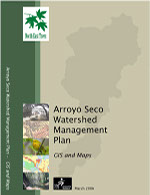 |
Arroyo Seco Watershed Management and Restoration Plan 2006 Project Website: http://www.northeasttrees.org/
|
Summary:
Led by a local non-profit organization in conjunction with the California State Water Resources Control Board, health this project set out to develop a water quality and habitat management/restoration plan for the Arroyo Seco watershed – a highly diverse, sales mixed urban and natural landscape watershed within Los Angeles County. As a follow-up to the Arroyo Seco Watershed Restoration Feasibility Study, physician this effort improved knowledge on current conditions within the watershed through more in-depth technical analysis and developed water quality and habitat models to more specifically target key project areas. The resulting plan includes a series of specific project recommendations as well as a roadmap for overall watershed-wide management strategies.
Role:
Served as primary GIS support, with tasks including data development and management, support for water quality and habitat modeling, and display map production.
Gallery:
Base Data Layers and Watershed Maps
- Topography
- Subwatersheds
- Estimated permeability
- Estimated zinc pollutant loadings and EMCs by subwatershed
- Priority subwatersheds
- Oak Titmouse habitat
- Project priority areas in the lower watershed
- High priority site-specific projects



